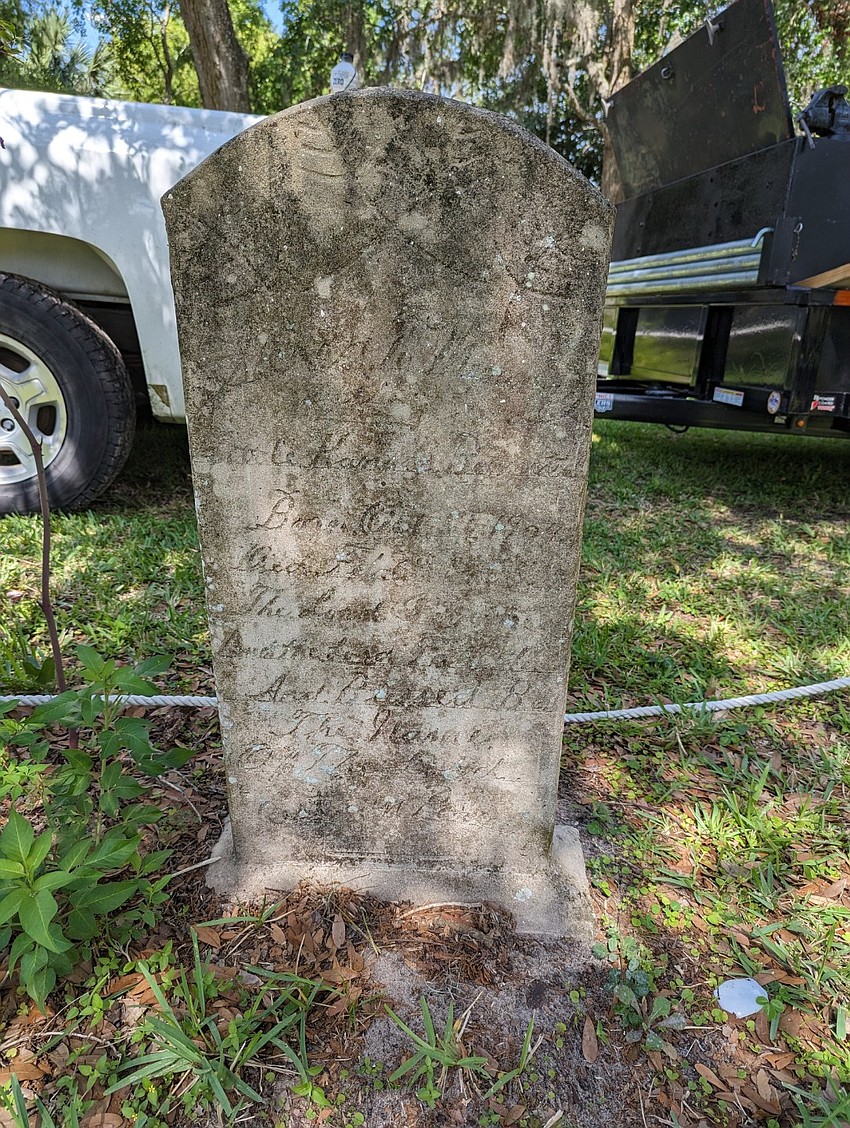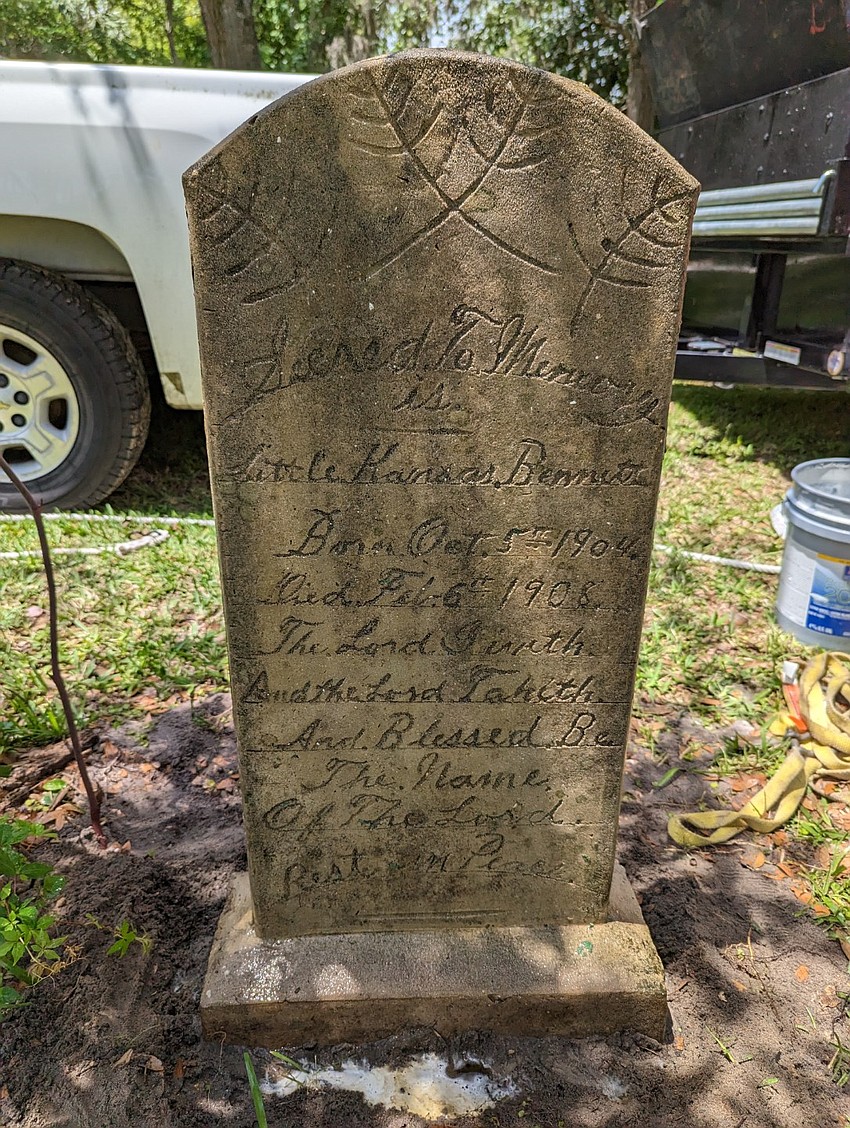- December 15, 2025
Steve and Brenda Fecher spend most of their weekends cleaning and lifting sunken headstones at Pilgrims Rest Cemetery in Ormond Beach. Photo by Jarleene Almenas
Brenda and Steve Fecher have spent the last year restoring the Pilgrims Rest Cemetery. Photo by Jarleene Almenas
Brenda and Steve Fecher work to raise Kansas Bennett's headstone. Photo by Jarleene Almenas
Brenda Fecher's great great-aunt, Kansas Bennett, was the first person to be buried at Pilgrims Rest Cemetery. Photo by Jarleene Almenas
Brenda and Steve Fecher work to lift Kansas Bennett's headstone. Photo by Jarleene Almenas
For Brenda Fecher, a headstone is more than a stone marker. It's a representation of life.
And as the third generation caretaker of Pilgrims Rest Cemetery in Ormond Beach, she wants to make sure those lives — no matter how long or short, how many decades have passed since their burial — are remembered. For the past year, Fecher and her husband Steve have been restoring, cleaning and raising headstones at the historic cemetery, as well as placing markers for long-forgotten unmarked graves.
"A lot of stones, you feel like are forgotten," Fecher said. "Some of these families have moved away. They've moved up north. They don't live here, so they don't have a lot of visitors and by us coming, we've brought back life into the cemetery."
Fecher took over as caretaker of the cemetery when her mother, Nancy Partridge, died in December 2021. Fecher's grandmother, Alberta Miller, was the caretaker before Partridge.
Still, Fecher, a kindergarten teacher at South Daytona Elementary, said the thought of one day taking care of the cemetery never crossed her mind. At least, until her mother became sick with cancer.
"It kind of became real at that point," Fecher said. "Like, 'Hey, I've got to step up and I've got to do something with the cemetery. So it's not something that I ever thought that I would do, but we enjoy it. We love doing it. It is a labor of love."
Fecher's family history dates back to the mid-1800s with some of Ormond Beach's earliest pioneers — the Winns, the Harpers, the Campbells, the Groovers and the Bennetts.
These families formed the Tomoka Settlement along the Tomoka River, and in 1879, a church was organized by the Groover Creek Cemetery, located in the middle of what is today the Tymber Creek subdivision. The church was used as a one-room school house and meeting place.
In 1895, after a freeze that destroyed many orange groves in the area, the families decided to move further east.
But they didn't want to leave the church behind. So in 1906, Walter Campbell and William Bennett, Jr. bought the land that is now Pilgrims Rest Cemetery and moved the church beside it by rolling it on logs pulled by mules.
In 1908, the first person was buried at Pilgrims Rest — 4-year-old Kansas Bennett, sister to Fecher's great grandmother, Vicie Bennett Winn. It's believed she died of chicken pox.

On Saturday, April 29, the Fechers cleaned Kansas's headstone and lifted it to rest above ground once again. The ground at the cemetery is soft, and the Fechers have discovered several buried grave markers during their work to restore the cemetery.
"So until we ... probe and find it by accident, we don't know what's there," Fecher said.
In the late 1990s, her aunt documented and photographed all of the cemetery's headstones, and as Fecher has looked through those photos, she's spotted headstones and foot stones she didn't recognize. They were there, only buried.
Recently, the Fechers stumbled across two infant foot stones for Winn family members near the fence. Steve Fecher was probing the ground and suddenly, the sound of the device changed.
"We're like, 'That doesn't sound like concrete," Brenda Fecher said. "'That doesn't sound like coquina rock. ... It kind of sounded like metal, so very gingerly, we dig and we found two gorgeous foot stones."
"All of the sudden, this beautiful red granite stone starts staring at you," Steve Fecher added.
Like his wife, he also never saw himself as a caretaker of a cemetery one day.
"I didn't realize that when I got married, I was going to marry all of her dead relatives either," Steve Fecher said. "But it's probably, in my 53 years, the most gratifying work I've ever done."
Fecher's grandmother was not a member of the church, but she did love it.
The church would hold service once a month and Miller would often notice fresh dirt on the ground of the cemetery, but many were not sure who had been buried. So she along with a small group of other women began keeping records of the church and the cemetery.

Miller became the caretaker of the cemetery in 1953. The cemetery was then plotted for 130 spaces, and a clean up effort was organized once or twice a year.
"She pretty much lived her adult life taking care of the cemetery and keeping on traditions that way," Fecher said.
Fecher recalls how her grandfather would ride his riding mower from his house off Mason Avenue to and from the cemetery. The family jokes that the journey took him longer than the actual time spent mowing the cemetery, as he had to stop for gas both ways.
In 1988, Miller donated the church to the city of Ormond Beach after its land was sold. Thanks to an anonymous $68,000 donation, the church was moved and now rests at Bailey Riverbridge Gardens on the northwest corner of the Granada bridge.
As a child, her mother grew up playing in the cemetery, oftentimes after she and other children were kicked out of the church's service for disrupting, Brenda Fecher said.
"When mama passed, we had her celebration of life in the church," she said. "We thought that was very fitting."
Pilgrims Rest Cemetery is still an active cemetery. The Fechers estimate they have about 20 plots left.
They recently had a ground penetrating radar study done on the grounds to make sure headstones are in their correct spots. The couple also hopes to create an online database of who is buried where, with the aim to create a QR code people can scan to make it easier to find their family members.
In that process, they also found 14 anomalies in the ground. They could be unmarked graves, as was the case for two which have been claimed by family members, or they could signify a spot where the ground was simply disturbed.

"We definitely have spots where the ground has been dug," Steve Fecher said. "If it was a wooden box, it isn't there anymore."
The cemetery is also home to the graves of seven Confederate soldiers, with the possibility of an eight — one soldier has two headstones. Same name, same death date, but different birth date.
A monument paying tribute to fallen Confederate soldiers, including those buried in the cemetery, rests on the property.
The Fechers aren't paid to take care of the cemetery, where they spend most of their weekends for several hours a day. The cemetery is a nonprofit, so all donations go into its care. One fundraiser is held a year: an interactive tour of the cemetery held in partnership with the Ormond Beach Historical Society in October.
Taking care of the cemetery is their "yoga," the couple said.
"It doesn't matter how hard of a week I've had, what kind of people I've had to deal with, you come up here and it all goes away," Steve Fecher said.
The Fechers have been documenting their progress with the cemetery on their Facebook page. On every post concerning the restoration of a headstone, they write "Remembering a life." The phrase is also printed on the back of their Pilgrims Rest T-shirts they wear to work on the cemetery.
Restoring the headstones provides a feeling of instant gratification, Brenda Fecher said.
"You come out and you say, 'This stone, it needs some love. It needs to be cleaned. It needs to be raised up,'" she said. "And within 30, 45 minutes, it's up out of the ground. It's pretty. It's straight. It's level. It's not forgotten anymore."